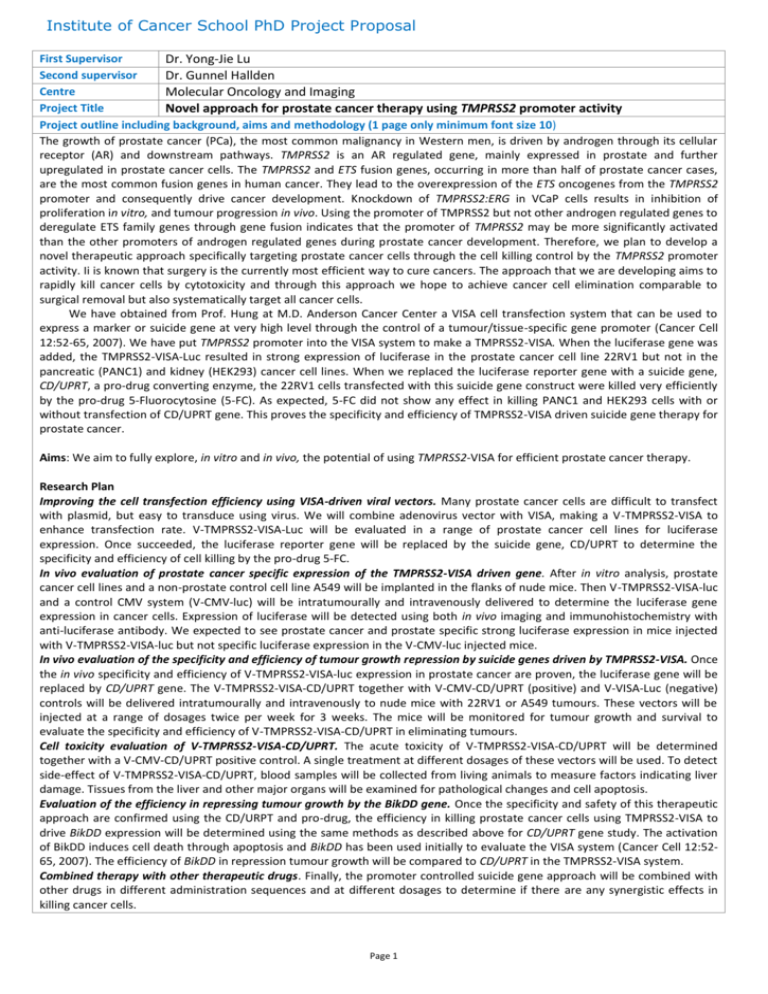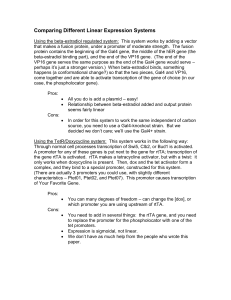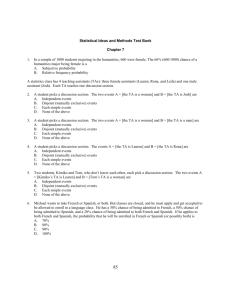42205
advertisement

Institute of Cancer School PhD Project Proposal First Supervisor Dr. Yong-Jie Lu Second supervisor Dr. Gunnel Hallden Centre Molecular Oncology and Imaging Project Title Novel approach for prostate cancer therapy using TMPRSS2 promoter activity Project outline including background, aims and methodology (1 page only minimum font size 10) The growth of prostate cancer (PCa), the most common malignancy in Western men, is driven by androgen through its cellular receptor (AR) and downstream pathways. TMPRSS2 is an AR regulated gene, mainly expressed in prostate and further upregulated in prostate cancer cells. The TMPRSS2 and ETS fusion genes, occurring in more than half of prostate cancer cases, are the most common fusion genes in human cancer. They lead to the overexpression of the ETS oncogenes from the TMPRSS2 promoter and consequently drive cancer development. Knockdown of TMPRSS2:ERG in VCaP cells results in inhibition of proliferation in vitro, and tumour progression in vivo. Using the promoter of TMPRSS2 but not other androgen regulated genes to deregulate ETS family genes through gene fusion indicates that the promoter of TMPRSS2 may be more significantly activated than the other promoters of androgen regulated genes during prostate cancer development. Therefore, we plan to develop a novel therapeutic approach specifically targeting prostate cancer cells through the cell killing control by the TMPRSS2 promoter activity. Ii is known that surgery is the currently most efficient way to cure cancers. The approach that we are developing aims to rapidly kill cancer cells by cytotoxicity and through this approach we hope to achieve cancer cell elimination comparable to surgical removal but also systematically target all cancer cells. We have obtained from Prof. Hung at M.D. Anderson Cancer Center a VISA cell transfection system that can be used to express a marker or suicide gene at very high level through the control of a tumour/tissue-specific gene promoter (Cancer Cell 12:52-65, 2007). We have put TMPRSS2 promoter into the VISA system to make a TMPRSS2-VISA. When the luciferase gene was added, the TMPRSS2-VISA-Luc resulted in strong expression of luciferase in the prostate cancer cell line 22RV1 but not in the pancreatic (PANC1) and kidney (HEK293) cancer cell lines. When we replaced the luciferase reporter gene with a suicide gene, CD/UPRT, a pro-drug converting enzyme, the 22RV1 cells transfected with this suicide gene construct were killed very efficiently by the pro-drug 5-Fluorocytosine (5-FC). As expected, 5-FC did not show any effect in killing PANC1 and HEK293 cells with or without transfection of CD/UPRT gene. This proves the specificity and efficiency of TMPRSS2-VISA driven suicide gene therapy for prostate cancer. Aims: We aim to fully explore, in vitro and in vivo, the potential of using TMPRSS2-VISA for efficient prostate cancer therapy. Research Plan Improving the cell transfection efficiency using VISA-driven viral vectors. Many prostate cancer cells are difficult to transfect with plasmid, but easy to transduce using virus. We will combine adenovirus vector with VISA, making a V-TMPRSS2-VISA to enhance transfection rate. V-TMPRSS2-VISA-Luc will be evaluated in a range of prostate cancer cell lines for luciferase expression. Once succeeded, the luciferase reporter gene will be replaced by the suicide gene, CD/UPRT to determine the specificity and efficiency of cell killing by the pro-drug 5-FC. In vivo evaluation of prostate cancer specific expression of the TMPRSS2-VISA driven gene. After in vitro analysis, prostate cancer cell lines and a non-prostate control cell line A549 will be implanted in the flanks of nude mice. Then V-TMPRSS2-VISA-luc and a control CMV system (V-CMV-luc) will be intratumourally and intravenously delivered to determine the luciferase gene expression in cancer cells. Expression of luciferase will be detected using both in vivo imaging and immunohistochemistry with anti-luciferase antibody. We expected to see prostate cancer and prostate specific strong luciferase expression in mice injected with V-TMPRSS2-VISA-luc but not specific luciferase expression in the V-CMV-luc injected mice. In vivo evaluation of the specificity and efficiency of tumour growth repression by suicide genes driven by TMPRSS2-VISA. Once the in vivo specificity and efficiency of V-TMPRSS2-VISA-luc expression in prostate cancer are proven, the luciferase gene will be replaced by CD/UPRT gene. The V-TMPRSS2-VISA-CD/UPRT together with V-CMV-CD/UPRT (positive) and V-VISA-Luc (negative) controls will be delivered intratumourally and intravenously to nude mice with 22RV1 or A549 tumours. These vectors will be injected at a range of dosages twice per week for 3 weeks. The mice will be monitored for tumour growth and survival to evaluate the specificity and efficiency of V-TMPRSS2-VISA-CD/UPRT in eliminating tumours. Cell toxicity evaluation of V-TMPRSS2-VISA-CD/UPRT. The acute toxicity of V-TMPRSS2-VISA-CD/UPRT will be determined together with a V-CMV-CD/UPRT positive control. A single treatment at different dosages of these vectors will be used. To detect side-effect of V-TMPRSS2-VISA-CD/UPRT, blood samples will be collected from living animals to measure factors indicating liver damage. Tissues from the liver and other major organs will be examined for pathological changes and cell apoptosis. Evaluation of the efficiency in repressing tumour growth by the BikDD gene. Once the specificity and safety of this therapeutic approach are confirmed using the CD/URPT and pro-drug, the efficiency in killing prostate cancer cells using TMPRSS2-VISA to drive BikDD expression will be determined using the same methods as described above for CD/UPRT gene study. The activation of BikDD induces cell death through apoptosis and BikDD has been used initially to evaluate the VISA system (Cancer Cell 12:5265, 2007). The efficiency of BikDD in repression tumour growth will be compared to CD/UPRT in the TMPRSS2-VISA system. Combined therapy with other therapeutic drugs. Finally, the promoter controlled suicide gene approach will be combined with other drugs in different administration sequences and at different dosages to determine if there are any synergistic effects in killing cancer cells. Page 1 Institute of Cancer School PhD Project Proposal A short (200 word) summary of the project to go with the studentship advert. The TMPRSS2 and ETS fusion genes occur in more than half of prostate cancer, the most common malignancy in Western men. They lead to the overexpression of ETS oncogenes from the TMPRSS2 promoter and consequently drive cancer development. We plan to develop a novel therapeutic approach targeting specifically at prostate cancer cells using TMPRSS2 promoter activity. We have put the TMPRSS2 promoter into a gene expression amplification system to drive high-level expression of a suicide gene and confirmed the specificity and efficiency of using this novel system to kill prostate cancer cells in vitro. In this project, the potential to use adenovirus for efficient delivery of the TMPRSS2-VISA will be explored in vitro and in vivo. The efficiency and safety of this therapeutic system in eliminating prostate cancer cells will also be tested in combination with other cancer therapeutic drugs. The project will involve the use of in vitro and in vivo model systems to investigate the potential of this novel therapeutic approach by bio-engineering the TMPRSS2 gene promoter, reporter and suicide genes and adenovirus vectors. During the course of the project the student will receive training in a wide range of techniques, including: DNA cloning and recombination, viral vector production, mammalian cell culture, cell transfection, cell viability assay, flow cytometry, quantitative PCR, florescence in situ hybridisation, DNA sequencing, Western blotting, immunofluorescence and immunohistochemistry, adenoviral techniques and in vivo imaging. Page 2






